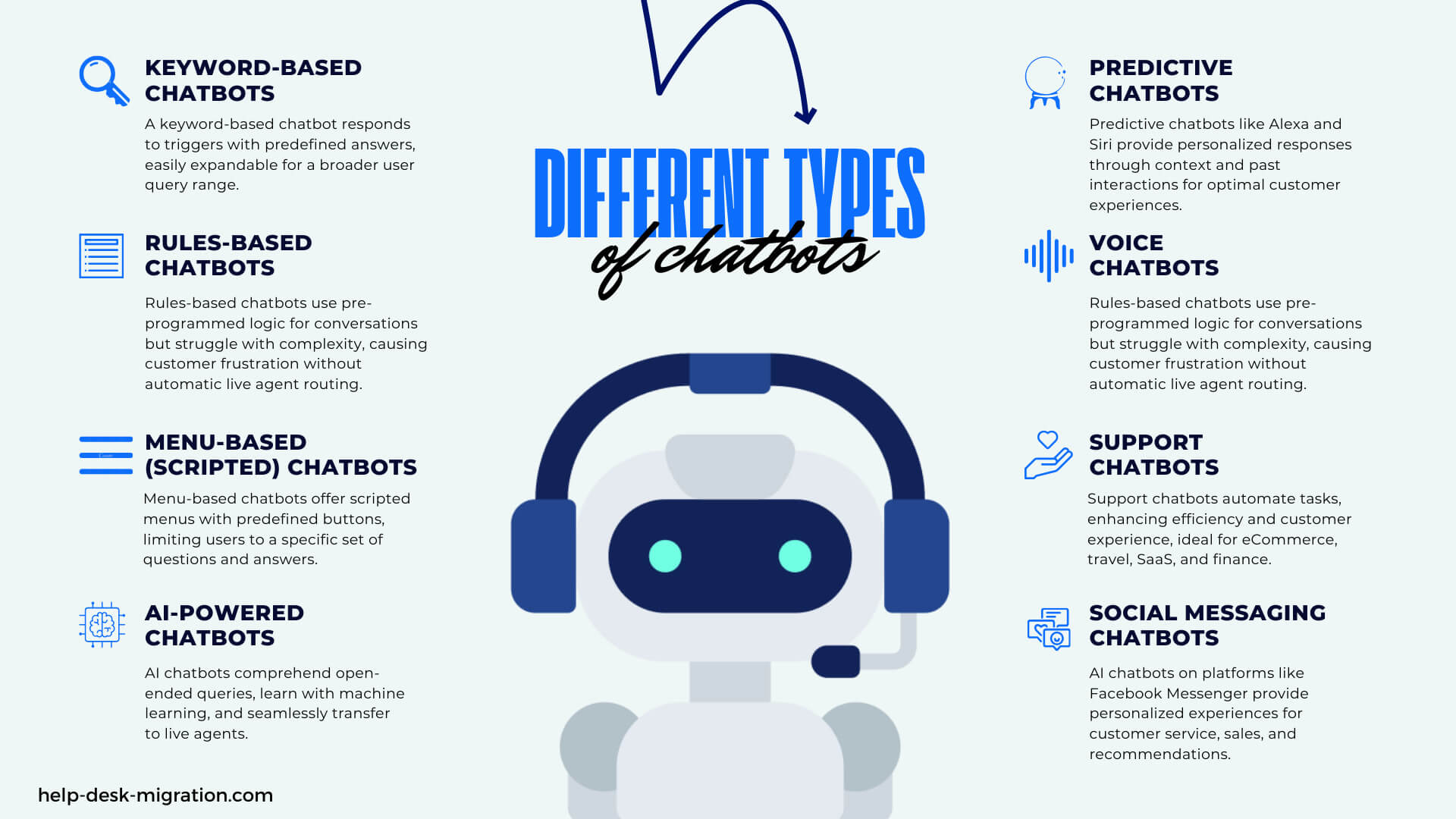The right type of chatbot can keep your customers engaged and your support representatives productive. It will also reduce operational costs for you while enabling the type of experience that keeps customers loyal to your brand. But with so many different chatbot types around, how do you choose the right one?
TL;DR
- A chatbot is a computer program designed to mimic human conversation, leveraging AI algorithms to interact with users effectively. Typically used in customer service, chatbots offer 24/7 support, handle common queries, and can be deployed across multiple channels.
- Chatbots use classification models like pattern matchers, algorithms, and artificial neural networks to understand and respond to user queries.
-
Different types of chatbots:
- Keyword-based chatbots:
- Functionality: Recognize specific keywords or triggers and provide predefined responses based on them.
- Use cases: Ideal for handling straightforward inquiries or FAQs where responses can be predetermined.
- Rules-based chatbots:
- Functionality: Operate on if/then logic, following predetermined conversational paths based on predefined rules.
- Use cases: Suitable for guiding users through scripted interactions or decision trees, but may struggle with handling complex queries.
- Menu-based (scripted) chatbots:
- Functionality: Offer users a menu of predefined options or actions to choose from, typically presented as buttons or prompts.
- Use cases: Effective for guiding users through specific tasks or processes in a structured manner, but limited in handling spontaneous inquiries.
- AI-powered chatbots:
- Functionality: Use NLP to understand and respond to user queries in a conversational manner.
- Use cases: Capable of handling open-ended inquiries, providing personalized responses, and learning from interactions to improve over time.
- Predictive chatbots:
- Functionality: Utilize historical data and machine learning algorithms to anticipate user needs and provide proactive, personalized recommendations.
- Use cases: Suited for personalized experiences, product recommendations, and targeted marketing messages based on user behavior and preferences.
- Voice chatbots:
- Functionality: Enable users to interact with the system through spoken commands or queries, leveraging speech recognition technology.
- Use Cases: Provide hands-free interaction for users, particularly useful in scenarios where typing may be cumbersome or inconvenient.
- Hybrid chatbots:
- Functionality: Combine elements of rule-based and AI-powered chatbots, offering a seamless transition between automated and human-assisted interactions.
- Use cases: Effective for handling a wide range of inquiries, escalating complex issues to human agents when necessary, and providing a personalized user experience.
- Support chatbots:
- Functionality: AI-powered virtual assistants designed to handle a wide range of tasks, including FAQs, troubleshooting technical issues, providing product recommendations, and guiding users through self-service options.
- Use cases: Automate routine tasks in customer support, improving efficiency, reducing response times, and enhancing the overall customer experience.
- Social messaging chatbots:
- Functionality: AI-powered virtual assistants that interact with users through messaging platforms and social media channels.
- Use cases: Provide personalized and interactive experiences, these chatbots deliver information, services, and support directly within messaging conversations
- Declarative chatbots:
- Functionality: Rely on predefined rules and responses, representing a simpler form of conversational AI technology.
- Use cases: Easier to build and maintain compared to more advanced counterparts, making them suitable for SMEs and service-based businesses.
- Keyword-based chatbots:
-
The economic impact of chatbots
- Affordable 24/7 customer service:
- Cost savings: Chatbots allow businesses to provide round-the-clock customer support without incurring additional labor costs associated with hiring and managing human agents for night shifts or overtime.
- Fixed costs: Implementing chatbots typically involves lower, fixed costs compared to staffing human agents, contributing to overall cost savings for businesses.
- Increased customer satisfaction:
- Accessibility: Chatbots enable customers to reach businesses at any time, day or night, leading to increased accessibility and responsiveness, which in turn enhances customer satisfaction.
- Consistency: Chatbots provide consistent responses to customer inquiries, free from human errors or biases, resulting in a more reliable and satisfying customer experience.
- Greater employee satisfaction:
- Task Offloading: By handling repetitive inquiries and tasks, chatbots free up human agents to focus on more complex and fulfilling responsibilities, leading to increased job satisfaction among employees.
- Productivity: With chatbots handling routine tasks, human agents can devote more time and energy to tasks that require critical thinking and problem-solving, leading to higher productivity levels.
- Affordable 24/7 customer service:
-
Consider while choosing the right chatbot:
- Purpose and capabilities:
- Define specific tasks for the chatbot, like customer inquiries or sales support.
- Assess needed capabilities; for complex queries, prioritize advanced NLP.
- Integration into existing tech ecosystem:
- Evaluate seamless integration with CRM, help desk, or eCommerce systems.
- Ensure compatibility with APIs and third-party applications.
- Multilingual support:
- Determine if multilingual support is needed for diverse audiences.
- Assess scalability of multilingual features for expanding into new markets.
- Customizability:
- Tailor the chatbot to reflect your brand identity.
- Look for customization options like branded avatars and personalized greetings.
- Scalability:
- Anticipate future growth; ensure the chatbot can handle increased interactions.
- Evaluate scalability in terms of performance and additional feature capacity.
- Security and compliance:
- Verify compliance with industry standards like GDPR or HIPAA.
- Assess security features such as encryption and access controls.
- Cost of adoption and maintenance:
- Consider setup costs, licensing fees, and ongoing maintenance expenses.
- Compare pricing models and evaluate total cost of ownership.
- Vendor reputation and support:
- Research vendor reputation and track record; check customer reviews.
- Assess the level of customer support, responsiveness, and updates.
- User experience:
- Prioritize seamless interaction and engagement.
- Conduct user testing to refine the chatbot's interface and flow.
- Trial periods for testing:
- Use trial periods to evaluate functionality, performance, and compatibility.
- Make informed decisions based on trial usage and feedback.
- Purpose and capabilities:
- Want to switch your current help desk to a new customer service tool with a chatbot? We are here to help you out: here you are select your future platform and use Migration Wizard to test it by importing a small batch of data before going to full migration.
Here, we'll introduce you to the many different types of chatbots and the criteria you need to assess to find the right match for your business.
What is a chatbot?
A chatbot is a computer program designed to simulate a conversation by making human-like responses to text or voice commands, typically over the Internet. Chatbots are often powered by AI algorithms that enable them to understand and respond to user queries and commands in a conversational manner.
This technology is commonly used in customer service, offering a cost-effective way to quickly respond to customer queries 24/7. Support bots answer common customer queries, resolve simple problems, and route more complex ones to the right agents or departments if human interaction is needed. They can also collect contact information, recommend products, and solicit customer feedback.
Chatbots can be deployed across multiple channels. For example, you might come across social media chatbots when reaching out to brands through Facebook Messenger, Instagram, X (formerly Twitter), and WhatsApp.
Before we show you the different types of chatbots to choose from, let’s have a quick look at how they work.
How does a chatbot work?
Chatbots deliver answers to questions using any of the following classification models:
Pattern matchers
Chatbots can be created using Artificial Intelligence Markup Language (AIML), a specialized markup language that subscribes to a predefined pattern-matching and response generation approach. The bots identify patterns and provide responses associated with them.
For example, a chatbot may be programmed to respond to “Who is Elon Musk?” with “Elon Musk is the founder of SpaceX.” A customer who types in a question that triggers the same pattern or word associations, such as, “Do you know who Elon Musk is?” will get the same response from the chatbot.
Algorithms
An algorithm organizes data into a hierarchy, creating many different pattern combinations. It then uses an equation to reduce the number of patterns, come up with a simpler structure, and dig up the most suitable response to each question.
For example, the Multinomial Naive Bayes algorithm may count the occurrence of each word in a set of sentences, account for their commonality, and assign a score accordingly. The scores are then compared to that of an input sentence (a question) and the best associations are created (the answer to the question).
Artificial neural networks
Artificial neural networks use weighted connections (or the scores assigned to associations between words) to calculate the output from the input, making iterations as they continuously train on the data. They keep improving how they weigh connections or assign scores to word associations, putting out increasingly accurate outputs. They have a higher degree of autonomy than algorithms, learning from every interaction and error.
These classification models come in many variations, depending on the chatbot type.
How many different chatbot types are out there?
Chatbots vary in complexity. Simple types of chatbots allow users to click on a menu of questions, while the more sophisticated ones enable customers to type in or dictate open-ended questions. Here are the different chatbot types:

1 Keyword-based chatbots
A keyword recognition-based chatbot recognizes relevant keywords and provides answers accordingly. They can only respond to a predefined list of keywords or triggers, have a very limited understanding of intent, and are only capable of providing fixed answers.
These chatbots are easy to develop and expand. You can readily update them with keywords and responses, widening the range of user queries they can cover.
2 Rules-based chatbots
A rules-based chatbot uses conditional if/then logic to pre-program conversation flows, putting together question-and-answer combinations. Because rule-based chatbots follow a pre-written playbook, they fall short when the questions get too complex. This often leaves customers frustrated, especially if they are not automatically routed to a live agent.
3 Menu-based (scripted) chatbots
Menu-based chatbots are even simpler than their rule-based counterparts, offering a scripted menu. Instead of typing in their own queries, users can only choose from predefined buttons.
A button-based chatbot is limited to a very specific set of questions and answers specified on the menu.
4 AI-powered chatbots
AI-powered chatbots are capable of understanding and addressing open-ended queries. Equipped with natural language processing (NLP) capabilities, they don’t just respond to pre-programmed triggers, but actually comprehend the language, context, and intent of the question, and then answer it accordingly. These contextual chatbots can even throw back a clarifying question if they are unsure of the best response.
Machine learning algorithms allow these contextual chatbots to self-learn, improving with every interaction. Over time, they get better at responding to questions, even complex ones. They can also seamlessly transfer the conversation to a live agent.
5 Predictive chatbots
These virtual assistants are a more specific type of AI-powered chatbot designed to provide personalized responses to user queries. Predictive chatbots use context and past conversations to understand complex questions and respond appropriately.
They require sophisticated training models and rich data to work, but it’s all worth the effort because they provide the best customer experiences. The popular virtual assistants Amazon’s Alexa and Apple’s Siri are examples of predictive chatbots.
6 Voice chatbots
Users interact with voice bots by speaking to them. Rudimentary chatbots are often powered by Interactive Voice Response (IVR) — a technology that allows users to leave a voice command and use the keypad to choose options from a menu.
Meanwhile, AI-powered voice chatbots leverage natural language processing to comprehend spoken questions and respond in a conversational tone. They’re capable of responding to open-ended questions. They boost resolution rates, increasing the likelihood of leaving both customers and agents satisfied.
Voice chatbots offer the added benefit of not having to type in queries.
7 Hybrid chatbots
A hybrid chatbot model combines the simplicity of rule-based chatbots, the sophistication of AI-powered bots, and the personal touch of live support representatives. They offer a seamless system where a simple chatbot answers generic questions, an AI bot takes over when the questions get complex, and an agent steps in when the issue remains unresolved.
Hybrid bots are ideal for companies with a huge influx of queries. And because it’s complex to set up, it works best for large enterprises.
8 Support chatbots
Support chatbots are AI-powered virtual assistants designed to handle a wide range of tasks, including answering frequently asked questions, troubleshooting technical issues, providing product recommendations, and guiding users through self-service options. By automating these routine tasks, support chatbots can help businesses improve efficiency, reduce response times, and enhance the overall customer experience.
Support chatbots can be deployed across various channels, including websites, mobile apps, and messaging platforms. They perform great for eCommerce, travel and hospitality, SaaS companies, and financial services.
9 Social messaging chatbots
Social messaging chatbots are AI-powered virtual assistants that interact with users through messaging platforms and social media channels. These chatbots are designed to provide personalized and interactive experiences for users, delivering information, services, and support directly within messaging conversations.
Social messaging chatbots can serve a variety of purposes, including customer service, sales and marketing, lead generation, and personalized recommendations. For example, a retail brand could use a chatbot on Facebook Messenger to help customers find products, place orders, and track shipments.
10 Declarative chatbots
Declarative chatbots rely on predefined rules and responses, representing a simpler form of conversational AI technology. In contrast to sophisticated AI-driven chatbots, which employ NLP and machine learning algorithms to adapt and respond dynamically, declarative chatbots operate based on a predetermined set of rules and logic.
One of the key characteristics of declarative chatbots is their simplicity and ease of implementation. These chatbots are typically easier to build and maintain compared to their more advanced counterparts, making them an attractive option for SMEs, educational institutions, retailers, and service-based businesses like consulting, legal services, healthcare.
How do various types of chatbot impact the economic side of your business?
Chatbots bring benefits that impact businesses’ bottom line. They bring the following economic value:
1 Affordable 24/7 customer service
Chatbots allow customers to reach businesses and get answers to their queries 24/7. And they only require lower, fixed costs. Companies don’t have to shell out huge budgets for night-shift employees or overtime labor costs.
2 Increased customer satisfaction
Because chatbots allow users to reach a business round the clock, they help boost customer satisfaction. They also offer the added benefit of being free from human errors and bias, offering consistent responses to the same questions.
3 Greater employee satisfaction
Because chatbots take over repetitive inquiries, agents can focus on tasks that are more challenging and fulfilling. This increases the agents’ productivity and satisfaction levels, reduces employee turnover rates, and boosts skill levels.

Labor cost savings and employee and customer satisfaction ultimately result in reduced costs and increased revenue. To make the most of these economic benefits, you need to choose the right chatbot types for your business. An unsuitable chatbot can cost more than necessary or fail to fully meet your needs, leading to inefficiency and missed opportunities.
Which types of chatbot do your business need?
To fully capture the benefits of using virtual assistants, you need to choose a chatbot type to meet your business goals. So, before you kickstart your search, take a step back and look at your business needs. What do you need the virtual assistant for? The answers will help you define the features you need, thus guiding your choice.
Let’s give you a couple of examples.
As mentioned above, one of the main reasons businesses deploy chatbots is to ensure customers have readily available answers to their queries. When they chat in with questions, especially pressing concerns, your business should be ready to assist.
If this is an area of focus for you, make sure you choose a chatbot that provides quick replies, delivers accurate answers to common questions, matches the queries’ level of complexity, and routes concerns to the right agent when necessary.
- Sales and marketing
You may need chatbots to capture prospects, gather data, qualify leads, automate outreach, and nurture leads.
In this case, choose chatbots capable of responding to queries, directing them to a lead form, sending follow-up messages, recommending products, and other such sales and marketing tasks.
Why is the right type of chatbots important for your business?
While sifting a variety of chatbots through your business goals will considerably narrow down your choice, these are not the only things you should take into consideration when making a choice. Here are the criteria for selecting chatbot type:

1 Meets your purpose and offers proper capabilities
What exactly do you need the chatbots for? Assess your business needs in more detail and clearly define the functionalities the chatbots will be covering.
For example, if you need your chatbot able to remember past interactions with customers, consider a solution with machine learning capabilities. Do your customers come to you with complex questions? Make sure you choose a chatbot with natural language processing (NLP) capabilities and comprehension levels that match the types of questions your customers ask.
2 Ease of integration into the tech ecosystem you have
The chatbots you choose should also fit seamlessly into your existing systems. You can speak with the chatbot software providers to explore your options. Ask about compatibility concerns, set-up or configuration service, and deployment assistance.
3 Multilingual support to answer questions in many languages
Do your services cross borders? Will you have to cater to customers who speak foreign languages? Make sure your chatbots have the capacity to provide multilingual services when necessary.
4 Customizability to tailor chatbot to your brand
Your chatbots should adequately represent your business. This means having just the right conversational tone and brand identity (the right avatars, fonts, and colors).
5 Scalability as your business grows
The chatbots you choose should be capable of growing along with your business. If you need to handle larger volumes of customers, the bots should be able to accommodate the workload.
6 Security and compliance with industry standards
The chatbots must meet the latest security protocols and regulatory standards. They must also have the necessary access controls to prevent breaches.
7 Cost of adoption and maintenance should meet your budget
Choose a chatbot that your business can afford. Consider the initial setup, maintenance, monthly or annual payments, and any fees that may not be immediately apparent.
8 Vendor reputation and support matter a lot
Take the time to check third-party sites for customer feedback. You can also reach out to existing clients and ask how their experience has been. And make sure you ask the chatbot provider about their after-sales services.
9 Great user experience for employees and customers
It’s not enough that the chatbot has all the features and specifications you need, it should also be easy to use. Make sure the interface is intuitive and user-friendly. This helps ensure a high adoption rate and a positive experience for your employees and customers.
10 Trial periods help to try and test before committing to
One of the best ways to ensure you’re choosing the right chatbot is to experience it for yourself. And you can do this by signing up for a free trial before fully committing to a purchase.
What type of chatbot do you need?
Chatbots bring benefits to your business that directly and indirectly impact your bottom line. The right chatbot type will reduce operational and labor costs, boost revenue, and keep customers and employees satisfied. Chatbots can also gather invaluable data, bringing insights that improve the way you make business decisions and approach your customers.
To fully capture these benefits, you need to pick the right chatbot type. And you need to make sure it integrates seamlessly into your existing system.
Fortunately, many help desk solutions already have chatbots built into them. If you’d like to switch over to a system with a more suitable chatbot, Help Desk Migration can make the process easy for you. Try a Free Demo to see how it can take the heavy lifting out of transferring customer service data to the new customer service platform.
Frequently Asked Questions
While all chatbots serve the general purpose of automating conversations and providing assistance to users, they are not all the same. Businesses should carefully evaluate the functionality, technology, user experience, integration capabilities, and scalability of different chatbot options to choose the solution that best meets their specific needs and objectives.
Chatbots identify patterns and classify them to match queries with the best answers. They use any of the three classification models, namely pattern matchers, algorithms, and artificial neural networks.
Chatbots are a valuable tool for customer service, offering instant responses, scalability, consistency, cost-effectiveness, personalization, and integration capabilities. By leveraging chatbots for customer service, businesses can improve efficiency, enhance the customer experience, and drive higher levels of satisfaction and loyalty among their customers.
The right chatbot types can bring cost savings in terms of reduced operational and labor costs. An appropriate chatbot spectrum also improves the way you deliver customer satisfaction, boosts employee productivity, and captures revenue.
While there are several AI technologies available for customer service, the best choice depends on your specific business needs, objectives, and technical capabilities. Here are some of the top AI technologies commonly used for customer service:
- NLP-powered chatbots can analyze customer inquiries, extract relevant information, and generate appropriate responses in natural language.
- ML-powered chatbots can learn from past interactions with customers, improving over time and providing more accurate and personalized responses.
- Sentiment analysis uses NLP and ML techniques and it can help businesses understand customer feedback, identify areas for improvement, and prioritize customer inquiries based on urgency or sentiment.
- Speech recognition can be used in conjunction with voice-enabled chatbots or virtual assistants to enable customers to interact with businesses using natural language voice commands.
- Predictive analytics can help businesses anticipate customer needs, identify potential issues before they arise, and proactively address customer concerns.



